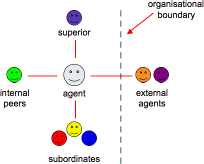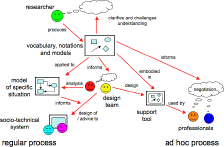Outline
This is the last chapter in Responsibility and Dependable Systems and tries to bring together various aspects of modelling in the book.
The chapter begins with a case study using the causal responsibility modelling from Chapters 8 and 9 looking at both goal structure and patterns of delegation. The case study used is the process of preparing the book itself, from orignal inception until and beyond publication. The process turns out to be highly dynamic in terms of its unfolding responsibility structure and also complex in terms of its multiple and interwoven relations between parties. We elaborate several of these themes in the latter parts of the chapter.
The information elicitation in the case study uses a variety of techniques, field observations, interviews and examination of artefacts such as emails and chapter drafts. Because of the nature of the case study, different methods of elicitation were applied at different phases and this is likely to be the case with any application of modelling.
A notable aspect of the case study is its rich temporality: both in terms of process and responsibility. The models did not address these explicitly, but by allowing precise formulation of snapshots of responsibility enabled us to expose and discuss this temporal structure.
We identify three types of dynamism related to ad hoc, singular and ordinary processes. These different types of dynamism suggest different forms of application of the models: used informally as a vocabulary for discussion, applied formally as a method for analysis and potentially embodied in support tools.
We also discuss the way in which the process flow of activities between agents also created flows of causal responsibility and the problematic nature of consequential responsibility in such cases. We note how the common pattern of 4Rs (request, receipt, response, release), that has been reported in earlier work on temporal modelling of processes [1], often implies a shift of responsibility between agents at the response stage. Recognising the potential dangers of gaps in responsibility suggests common ways to 'patch' problems, notably through self-healing processes or through process ownership.
The dynamic flow of responsibility also highlights the way in which consequential responsibility can be implicitly 'passed on' and hence discharged without fulfilment of obligations. This leads to recognition of other ways in which this could occur, some legitimate others not. We particularly note potential problems that arise due to peer–peer responsibility relationships.
Whilst it is common to focus on the negative ways in which people can 'pass the buck' and in other ways fail to meet responsibilities, we also note the importance of felt responsibility and how appropriate professional and organisational ethos can lead to self management and hence dependable systems.
Finally, we consider the way models of responsibility play a dialogical role during design and potentially during the use of ad hoc processes, picking up the earlier discussion on types of dynamism. Whilst the models are not complete they play their part in the 'game' of design allowing a rich discussion of potential problems and solutions, and just as important, identifying successful, fault tolerant patterns.
|

[full size]
Kinds of organisational relationships

[full size]
Dialogical roles of responsibilty models
References
- Dix, A., Ramduny-Ellis, D., & Wilkinson, J. (2004) Trigger Analysis - understanding broken tasks. In The Handbook of Task Analysis for Human-Computer Interaction. D. Diaper & N. Stanton (eds.) Lawrence Erlbaum Associates, pp 381-400.
- Report of the Inquiry Into the Ambulance Service (1993, February) International Workshop on Software Specification and Design Case Study. With kind permission from The Communications Directorate, South West Thames Regional Health Authority. Original ISBN No: 0 905133 70 6.
- Winnograd T (1988, December) Where the action is. Byte, pp 256-258.
- Winograd, T. & Flores, F. (1986) Understanding computers and cognition: A new foundation for design. Reading, MA. Addison-Wesley.